GIGABYTE builds motherboards for pretty much every type of user, from the extreme high end board to the more basic and straightforward mainstream boards. We were able to pick up the Z77X-UP7 from GIGABYTE. Let’s take a look at how this top-end board performs.
Introduction – GIGABYTE Z77X-UP7
GIGABYTE has a wide market reach, and they can really throw their weight around in any segment they choose as they have plenty of models and manufacturing to do so. As of recent they have thrown their hat into the overclocking arena more heavily than before and this is of course at a similar time when many manufacturers are doing just the same. This kind of competitiveness is excellent for the consumer as each company will push to be the best which means so much better pricing and performance for the end user.
Today we have the Z77X-UP7 which is the board that GIGABYTE sees as the true successor to the famed X58A-OC board. That board was an absolute marvel as it arrived on scene quite late but it made up for its lateness with raw power. One thing it was missing was the more pedestrian IO connectivity, and as a result, general 24/7 usage was a bit unrealistic. We can see elements of the X58A-OC here on the Z77X-UP7 and performance is very promising. The UP7 however does offer some improvements to what we saw with the X58A-OC board. GIGABYTE realized that despite its benching capability, users will still want the regular usage to be excellent, and so they built the Z77X-UP7 with features great for benching and for 24/7 usage.
The board comes in at a price of $399.99 on Newegg, which puts it a bit above the Maximus V Extreme ($20.00 more at time of writing) and much above some other players out there but really in between most of the other 4-way SLI players.
Features & Specifications
32+3+2 Phase Power

One area this can sting though would be in the board cost as each component added adds cost so when your talking a 32Phase power design you gotta wonder if the added cost of that many components nets a necessary gain in performance. besides the massive 32 Phases there is a 3 Phase solution for DRAM and the last 2 dedicated to the iGPU. All in all it has a lot of VRM components and with it the promise of a lot of capability as well.
Well with GIGABYTEs own Hicookie grabbing the CPU frequency world record of over 7.1GHz on this very board on LN2 tells me it has something going on.
As you can see this is 32 Phases for the CPU alone of PowIRstage components. which allows for up to 2Kw of power to be delivered, not that any Ivy bridge would ever take that. There are so many PowIRstage chips that the same location on the rear is fitted with them as well just due to the sheer amount.
New Digital Power Design
GIGABYTE has long been a proponent of the analog power design. However, we have seen a noticeable shift towards digital power control, and with the Z77X-UP7they have shown their hand with a strong digital solution covering CPU, iGPU, Memory and VTT all falling in line behind a digital controller. This should speak well for the board’s capabilities, as digital solutions have proven to be excellent for precise power management and control, opening the doors for better power efficiency and tweakability when overclocking.
Designed for Overclockers
GIGABYTE intends this board to be targeted for those high end enthusiasts overclockers who want to set this up on a test bench and beat their CPU into submission. Features such as the dual BIOS switches allow for multi BIOS support with easy switching between the current BIOS for testing overclocks between BIOS revisions or even different BIOS profiles on each switch. The standard Debug LED or LCD POSTer is used to diagnose no POST conditions or hanging conditions which you will inevitably run into when under extreme cooling and trying to tweak and tune your system to record breaking speeds. The OC-Touch zone is home to all of the tweaking tuning and monitoring ability you can imagine and then some. Buttons to adjust CPU ratio, frequency and even a gear button to allow large frequency changes down to much more granular frequency stepping.(1MHz to 0.3MHz). Also in this area are a bunch of voltage measurement lead connectors which also come with included leads that allow easy connectivity of a multimeter to read critical voltages. The fact that the leads have a metal barrel design means that it will retain the probe so that monitoring can be accomplished without holding the probe against a specific point.
Multi GPU Optimized
The UP7 is one of the few high end board out there that offers 4 Way SLIand CrossFire capability with a PLX bridge chip to allow for up to 4 cards running at PCIe Gen 3 at x8 bandwidth. This is awesome in itself being the fact that these ivy bridge chips can really have some speed to them and if you allow multi card functionality to this max this could be an amazing 3D rig no matter if were talking gaming, render or benchmarking.
GIGABYTE 3D BIOS
GIGABYTE has implemented the 3D BIOS on the X79, and this is their form of a clickable UEFI GUI BIOS interface. The board image has been significantly improved and the interface smoothed out a little, but we will discuss that in more detail when it comes to the BIOS section of this review.
Virtu MVP
GIGABYTE has included Virtu MVP on their motherboard just like we have seen on other Z77 boards we have taken a look at recently. Virtu MVP allows the user to pair the iGPU and discrete cards for some really cool features, such as HyperFormance. HyperFormance pre-renders frames by the iGPU and removes some of the workload from the discreet GPU. This helps by delivering even higher framerates in games and other 3D applications.
GIGABYTE ON/Off charge
GIGABYTE does have a pretty neat feature: its ON/OFF charge. ON/OFF charge allows charging of even high load devices in all power modes, even (S5) power-off mode. This may not seem like such a big deal until you need to charge your phone and realize your system is off. Without this feature, you would have to power on your system and leave it on just to charge the device. With the ON/OFF feature, it’s not necessary to do that, and you can just have it plugged in without needing to worry about keeping your system powered on.
Ultra Durable 5
GIGABYTE has been promoting their Ultra Durable designs for some time now, and now with the Ultra Durable 5, GIGABYTE has added even more features into an already impressive package. Originally, we can remember when 2oz copper PCB was one of the biggest selling points, and now with Ultra Durable 5 standard the new er IOR fully digital controlled PWM has been put into action. This is a nice step from GIGABYTE and something I like to see as overall stability and overclock-ability are sure to be increased for those of us who really like to push the limits.
Here we see some of the new components that make up the Ultra Durable 5 changes which are the super high capacity power stages (MOSFET/driver packages) and high capacity Chokes.
The PowIRstage components are all in one mosfet/driver packages which include driver & high/low side mosfets all into a single chip package. This sort of design allows for superior loading capability, ultra fast response time and overall a much more compact implementation versus 3 or more separate chips which is what you get with a traditional design.
The Chokes in this package are specially selected for their ability to handle up to 30A a piece for extreme loading capability which means that they are super durable and able to handle pretty much any loading scenario you could throw at them all while being able to stay nice and cool.
ESD Protection
GIGABYTE has also built in ESD protection. ESD is ElectroStatic Discharge, which in a nutshell means all the little static spikes that can develop from you or even just the environment. These discharges are dangerous to components, as when you are dealing with micro voltages, many issues can develop from even the smallest blip. Humans always consider static to be harmless as it is just a small sting or tingle, but we fail to remember that those static discharges can be in the thousands of volts. Because of the low amperage, it won’t hurt a person, but it could still damage components. These ESD circuits are basically a buffer to protect the critical components and they take the brunt of the static shock to ensure the components live a nice happy life, or at least have a better chance of it.
For full specification listings see GIGABYTEs website here
Overview of the GIGABYTE Z77X-UP5 TH
The packaging is bold, black and orange it just jumps out at you screaming for attention. The front of the box holds some key features, and has icons across the bottom. It’s nothing new or groundbreaking but it works and looks awesome.
The flap folded open shows one side with a large window cutout showing off the board. Looking inside the front flap, we see a multitude of special features that are supported by the UP7 along with an indepth breakdown of the PowIRstage components.
The rear of the package highlights many of the talking points for the board. this includes many of the key features such as the 4-way GPU support, More on the PowIRstage components and 32 Phase VRM amongst many other things.
Lastly we see how the board is in the box as you remove the inner box from the packaging.
- User Manuals
- Installation Discs
- WiFi/BT 4.0 Card w/ Dual Antennae
- USB interconnect for WiFi/BT Card
- Voltage Check leads
- SATA Cables
- eSATA cables/brackets
- USB 3.0 Front panel 3.5″ bay
- SLIRibbon
- 3 Way SLIBridge
- 4 Way SLIBridge
- IO Shield
This accessory pack is more than enough to get this board up and running and definitely some cool stuff for overclocking and pushing your parts to the limit.
Here we see the whole board and how everything is configured. For the most part all of the primary connections are at the boards edge which makes for a much easier cable management. Cable management is important for high class system builds but for a benching rig it’s not as much so. When benching we still keep stuff out of the way but we’re not nearly as picky with wiring when it comes to the bench setup. One thing worth noting is that beyond the advertised 2oz copper PCB this board is also 10 layers deep to allow plenty of board strength, and with a board built for its overclocking heritage it is an excellent addition. Near the board’s edge where the SATA ports are located you will see a SATA power connector which is used for supplemental power to the GPU slots which will help bolster the power the slots get from the existing 24 pin ATX connector. Since this board supports up to 4 GPU’s concurrently, this connector is very much necessary otherwise the draw from the slot power for those cards could easily over stress the 24 pin ATX connector. The CPU 8 pin power plugs are doubled up here which will allow to feed the up to 2 kW of available power. This is somewhat unnecessary, but it doesn’t hurt to have it.
Click Image For a Larger One
- 6x USB 3.0 Ports
- D-SUB Output
- DVI-D port
- HDMi Connection
- DisplayPort connection
- SPDIF port
- 2x Gigabit LAN port
- up to 7.1 Channel HD audio via Realtek ALC898 Chipset w/ Optical S/PDIF output
This board offers plenty of connectivity, and besides the dual Gigabit LAN ports it also does have the included WiFi/BT 4.0 card to enable wireless connectivity for the system/board.
Click Image For a Larger One
The storage connectivity is handled primarily by the PCH via 4x SATA 3G capable ports and 2X SATA 6G capable ports. For the non-native ports we have a total of 4 gray ports which support SATA 6G speeds. Each pair of the gray ports comes from one of two installed Marvell 88SE9172 chips which means that a RAID 0 or 1 option is available for each pair, but the RAID cannot be spanned across the other ports, leading to a limit of 2 drives per controller.
The slot layout is excellent for anyone looking for some 4 Way SLI/CrossFire action or even possible compute card setups. One thing we think is nice is that with many super powerful triple slot cards on the market this layout can now offer superior slot spacing for those monster cards as the air gap will be there for even cooler running while allowing for the WiFi card to fit in the x1 slot between them. One thing worth noting is for those single card benchmarkers or even gamers, the black x16 slot offers a direct x16 gen 3 link to the CPU bypassing the PLX chip completely which will give the best possible single card performance.
The memory support once again is very standard for Z77 as it offers dual channel 4 slot configuration. Officially supported speed is showing up to 2400+ MHz and density up to 32GB which means either super fast or just a boatload of ram can be crammed into this board should either need arise.
Click Image For a Larger One
The upper right area near the DIMMs is reserved for GIGABYTE OC Touch zone. This is where the magic happens for hardware level adjustments as they can be made in real time allowing adjustments of both BCLK frequency and CPU ratio to allow quick adjustment as necessary for heavier or lighter benchmark loads. Here we also see the SATA power connector used to feed the GPU slots for supplemental power. This is a nice addition as it is close to boards edge for easy wire routing and hiding while also providing extra power needed by the slot connection to allow the 24 pin not to be over stressed. The two BIOS switches can be a little confusing unless you read up on them. One is used to select which BIOS chip is the active chip that the system will boot from. The other switch is used to enable or disable the BIOS recover feature which will use the other BIOS to flash a possibly corrupt BIOS back to a working condition. In a overclocking situation where failed POSTs can occur, this can cost a lot of time if the BIOS recovery kicks in and you end up freezing the board solid under LN2 waiting for the BIOS to flash itself back. The option to disable this feature and save this kind of time is a huge help and a very welcome feature.
Click Image For a Larger One
The audio is a 7.1 channel capable design fed by the Realtek ALC898 chipset and it also feeds a optical output connection should you want to feed your system audio directly to a capable reciever or eve high end speaker set. Here mid-board we have the PLX bridge chip which enables the 4 way GPU capability by multiplexing the available lanes to x8 with all 4 slots populated.
BIOS Overview
3D BIOS
Click Image To Enlarge
The advanced section is very similar to the older AMI BIOS that we have grown used to on the GIGABYTE boards of previous gen and although a bit more pretty without the super bright blue it simply works. The mouse does work in it but as the old school overclockers, we still want to navigate with the keyboard. A major advantage is that in the GIGABYTE UEFI you can manually type in the number you want whereas some other manufacturers require the setting be set by adjusting via arrows or Page Up/Page Down keys. The manual setting is key for us as once we know a setting being able to simply type it in makes things much faster, and when running LN2 every second saved is awesome.
Click Image To Enlarge
Here we see the basic system settings this is strictly informational and shows current system info. Also you can access ATA or hard drive info which can then be adjusted to enable or disable individual ports or even enabling or disabling advanced features such as hot plugging.
Click Image To Enlarge
Here is the BIOS features area and it covers most all of how the board POSTs and what order the board will try to boot from devices and also which devices or options may be enabled during POST.
Click Image To Enlarge
Here are the final peripheral and power settings to allow for setup of the rest of the minor settings along with power management and other common settings that we have seen on most boards. It is pretty standard fare but is laid out well and in a way that most users should have no issue locating the setting they are looking for.
Testing & Methodology
We’ve expanded our testing suite considerably since the X79 chipset release, and will continue to use the same methods for most of the motherboards and CPU’s we test. In the interests of thoroughness and accurate results, we run each test at least three times, and some tests more than that. We average the total of all the tests from each benchmark then report the average here.
The OS we use is Windows 7 Pro 64bit with all patches and updates applied. We also use the latest drivers available for the motherboard and any devices attached to the computer. We do not disable background tasks or tweak the OS or system in any way. We turn off drive indexing and daily defragging. We also turn off Prefetch and Superfetch. This is not an attempt to produce bigger benchmark numbers. Drive indexing and defragging can interfere with testing and produce confusing numbers. If a test were to be run while a drive was being indexed or defragged, and then the same test was later run when these processes were off, the two results would be contradictory and erroneous. As we cannot control when defragging and indexing occur precisely enough to guarantee that they won’t interfere with testing, we opt to disable the features entirely.
Prefetch tries to predict what users will load the next time they boot the machine by caching the relevant files and storing them for later use. We want to learn how the program runs without any of the files being cached, and we disable it so that each test run we do not have to clear pre-fetch to get accurate numbers. Lastly we disable Superfetch. Superfetch loads often-used programs into the memory. It is one of the reasons that Windows occupies so much memory. Vista fills the memory in an attempt to predict what users will load. Having one test run with files cached, and another test run with the files un-cached would result in inaccurate numbers. Again, since we can’t control its timings so precisely, it we turn it off. Because these four features can potentially interfere with benchmarking, and and are out of our control, we disable them. We do not disable anything else.
One thing to note is that we are revamping our testing method in order to better represent motherboard performance and offering to you guys the consumer. Also we want to make it an easier read for you without miles of endless charts. Please feel free to provide feedback on what you think as many benchmarks will be shuffled or removed completely.
Test Rig
| Test Rig | |
| Case | Thermaltake Level 10 GT |
| CPU | Intel Core i7-3770K |
| Motherboard | GIGABYTE Z77X-UP7 |
| Ram | 16GB Patriot Viper Xtreme 2400MHz + |
| CPU Cooler | Swiftech H20-220 Edge |
| Hard Drive | Western Digital Velociraptor 300GB |
| SSD | Intel 510 series SATA III 120GB |
| Optical | ASUS BD-ROM |
| GPU | Asus GTX680 Top/Intel HD 4000 |
| Additional Cards | N/A |
| PSU | Thermaltake Toughpower XT Platinum 1475W |
| Mouse | Tt esports Black gaming mouse |
| Keyboard | Tt eSPORTS Meka G1 mechanical gaming keyboard |
Test Suite
We will use the following applications to test the performance of the Motherboard. Benchmarks
| Benchmarks |
|---|
| PCMark 7 |
| 3DMark 11 |
| Cinebench R11.5 |
| Unigine Heaven 3.0 |
| SuperPi |
| Metro 2033 |
| SiSoft Sandra 2011b |
| X264HD |
Overclocking
Ever since the Sandy Bridge came around we have noticed a trend going on here. The boards make little difference when finding a 24/7 clock for gaming. The difference really happens when pushing on extreme benchmarks that the board will make a difference but for the most part under normal usage all of the boards perform very close to one another. This may seem a little confusing but to explain more clearly the newer architectures tend to be so easy to clock that the limit really does become the chip or cooling itself. Until you start delving into the extreme benchmarking and overclocking world all boards will do similar clocks at close to the same settings in most cases so clocking on this board was of little difference.
The UP7 clocks just like you would expect from an overclocking based board. It has many settings for voltages, and settings to increase the flexibility as you push the limit but honestly most settings can be left on auto for everyday gamer clocks (4.6GHz approx). Yes the board is capable of far more as it carried a record of over 7.1GHz just a short time ago but in order to pull that off you need one men chip as well. Testing up to 5GHz netted us similar results to what we saw with the Maximus V Extreme in the fact that it simply would take the settings and run.
One thing we have observed over the period of testing several Ivy bridge chips is that thermals can vary greatly so keep an eye on that as some run much hotter than others when overclocked.
Just to show how Ivy Bridge scales on superior cooling (LN2 in this case) you can see that the boards themselves are not the limit it is simply cooling needed to unlock the potential of these chips.
Important note: Overclocking can cause component failure. Please exercise caution when attempting any level of overclock on system components.
Temperatures
The temperatures were recorded with RealTemp while running wPrime 1024 right before the end of the 5th run. The results were recorded carefully. After the results were recorded, we waited for 30 minutes before taking Idle temperature measurements. The results were as follows:
| CPU Temperatures | Temperature (Idle/Load) |
| Z77X-UP7 OC (4.6GHz) | 32C/63C |
| Z77X-UP7 | 28C/51C |
| Chipset Temperatures | Temperature (Idle/Load) |
| Z77X-UP7 OC (4.6GHz) | 40C/46C |
| Z77X-UP7 | 35C/43C |
We used the same Swiftech LCS to ensure similar temperature comparisons available as similar application and mounting conditions were used.
Power Consumption
The power consumption was tested while running Wprime 1024 for a few minutes at stock settings. The results were recorded carefully with a Kill-A-Watt power consumption measuring tool at the wall. After the results were recorded, we waited for yet another few minutes minutes before taking Idle power consumption measurements.
| Configuration | Power Consumption (Idle/Load) |
| Z77X-UP7 (4.6GHz) | 197W/406W |
| Z77X-UP7 | 143W/339W |
The power consumption is not with GPU usage. This is with CPU/system loading but nothing graphically intensive in order to provide the most accurate results by not ramping up the GPU, which will pull significantly more power.
Synthetic Benchmarks
SiSoft Sandra 2011
“SiSoftware Sandra (the System Analyzer, Diagnostic and Reporting Assistant) is an information & diagnostic utility. It should provide most of the information (including undocumented) you need to know about your hardware, software and other devices whether hardware or software. It works along the lines of other Windows utilities, however it tries to go beyond them and show you more of what’s really going on. Giving the user the ability to draw comparisons at both a high and low-level. You can get information about the CPU, chipset, video adapter, ports, printers, sound card, memory, network, Windows internals, AGP, PCI, PCI-X, PCI-E (PCI Express), database, USB, USB2, 1394/Firewire, etc.”
SiSoft Sandra is one of those benchmarks that gives a good idea of how a platform can handle specific tasks. We like this benchmark as it does a decent job of showing small efficiency differences from board to board while not taking too long to run. We did find that the performance here was quite close to our first Ivy Bridge benches we have run and this just goes along with what we have seen as since Sandy Bridge was first introduced. Most boards perform within a percent or so of each other and therefore the separation from board to board is more based on features rather than performance. The Z77X-UP7 gets some top scores here and ranks toward the top of Z77 boards we have tested.
Superpi
SuperPi is a single threaded benchmark which measures efficiency and is heavily influenced by architectural changes as much as it is by clockspeeds.
SuperPi is a great efficiency benchmark and one we always use just because its simple and it shows improvements when they exist. The Z77X-UP7 is extremely efficient and works well.
X264HD
The X264 benchmark is all about encoding, and how well your CPU can do it. We know the 6 core chips for LGA2011 and 1366 are going dominate this as it has 50% more cores. For a comparison between Sandy Bridge and Ivy Bridge, there is a nice little performance increase likely due to the efficiency of the new die shrink. The UP7 does about average here and shows that overall the board can handle everyday tasks just as well as it does benchmarks.
Real World Benchmarks
3DMARK 11
3DMark 11 is the newest in Futuremark’s suite of benchmarking utilities. Its a fully capable DirectX11 benchmark which also stresses and analyzes the system performance as a whole to simulate a heavy rendering environment, such as a high end game or other application the end user may run. This benchmark was run with Performance settings 5 times and all runs were averaged for the results below.
In 3DMark 11 we opted for the Physics score as this test is CPU based and relies on no graphics, so we just see the CPU’s ability to render the preset Physics test. The UP7 once again take a nice spot in the running for the front here as the CPU performance and efficiency is simply very good.
Here we see the performance scaling in the 3D side of the benchmark and with a ASUS GTX680 installed. Keep in mind that the i7-2600K has a PCI-E 2.0 controller where the 3770K offers full PCI-E 3.0 compatibility. This shows a small improvement without the help of the Virtu MVP software. With MVP we do see some very fast results which we have seen previously but still is quite impressive that using the iGPU for this kind of performance increase can be done.
Unigine Heaven 3.0
Unigine Heaven is a benchmark program based on Unigine Corp’s latest engine, Unigine. The engine features DirectX 11, Hardware tessellation, DirectCompute, and Shader Model 5.0. All of these new technologies combined with the ability to run each card through the same exact test means this benchmark should be in our arsenal for a long time.
Here we see once again the GTX680 getting a slight increase from the switch to GEN 3 lanes, but once Virtu MVP was enabled it gets interesting again as the discrete GPU simply can do its job more readily and it shows in the FPS numbers.
Metro 2033
Here Virtu continues to impress on most fronts with some great performance and excellent scaling for what we’re sure will make some great gaming.
PCMark 7
PCMark 7 is a worthy synthetic full system benchmark, and we have found it a good measure of total system performance. The UP7 falls almost into a top spot again which shows that this board has some amazing tuning and efficiency just ready to help it explode onto the scene and it really does show no matter the test
Conclusion
The Z77X-UP7 is really a benching board, and nobody can deny that GIGABYTE brought its best to the ball park with this board. The UP7 has some serious capabilities and plenty of the right stuff to be competitive with the big boys in the professional overclocking arena.
The UP7 supports 4 Way SLI, which means benchmarks that scale with high GPU counts will be well suited for this board. The UP7 can also be run as part of a massive gaming build is also possible. The slot layout allows for dual triple slot cards to be placed while having an air gap for optimal cooling. The included Bluetooth and WiFi card allows for a vast array of wireless connectivity to your new custom build. The Dual BIOS support allows for worry free overclocks as even in the worst case scenario, you still have a spare BIOS left. The 32 Phase VRM allows for so much power to be fed to the CPU that we cannot see any situation where the CPU would be left wanting for more power.
The one real issue we can see with the UP7 is the price. It is a very expensive board; we believe some of this is due to the massive cost of the VRM design, which we assume was expensive to implement. The features on the board are nice, but when it performs the same as cheaper boards like the Maximus V Extreme, we feel the price should be lower as well. The features alone cannot justify such a high price, as the Maximus has some features of its own which provide added value to the board, while keeping the price reasonable.
Other than the high price, we cannot find any reason not to recommend this board. Its performance is simply stellar and with the features it has, it is simply waiting to be strapped to an LN2 pot for some record breaking fun. We do admire GIGABYTE’s daring in building a board with such an over-the-top VRM design, though it may not necessarily be needed.
| OUR VERDICT: GIGABYTE Z77X-UP7 | ||||||||||||||||||
|
||||||||||||||||||
| Summary: The Z77X-UP7 comes from an overclocking lineage and is ready to mix it up with the best in the bunch. With excellent features, it receives the Bjorn3D Golden Bear Award. |
 Bjorn3D.com Bjorn3d.com – Satisfying Your Daily Tech Cravings Since 1996
Bjorn3D.com Bjorn3d.com – Satisfying Your Daily Tech Cravings Since 1996





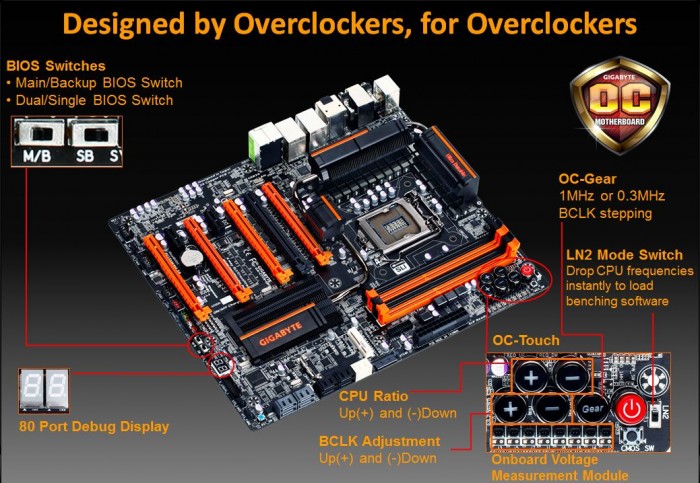









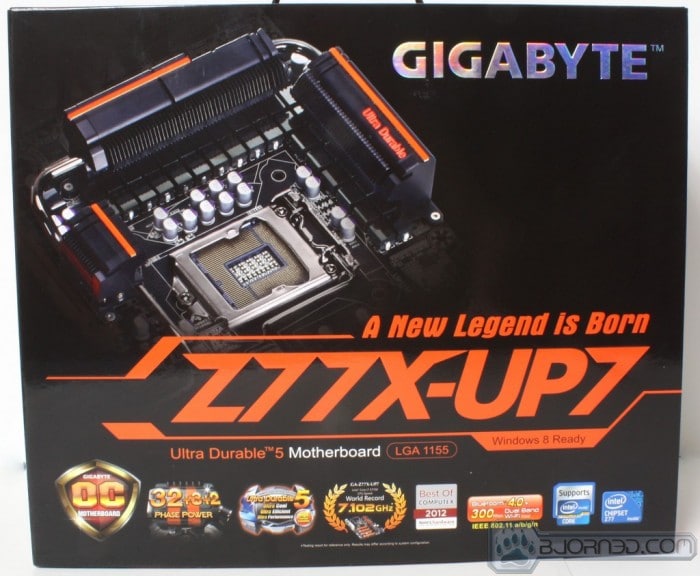













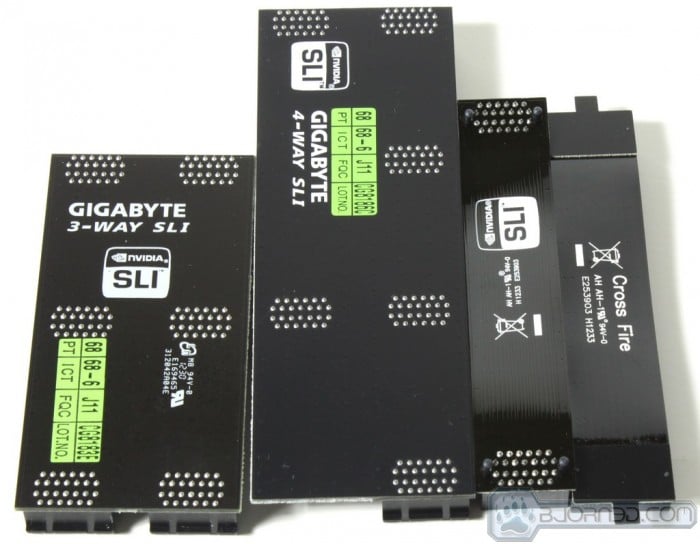




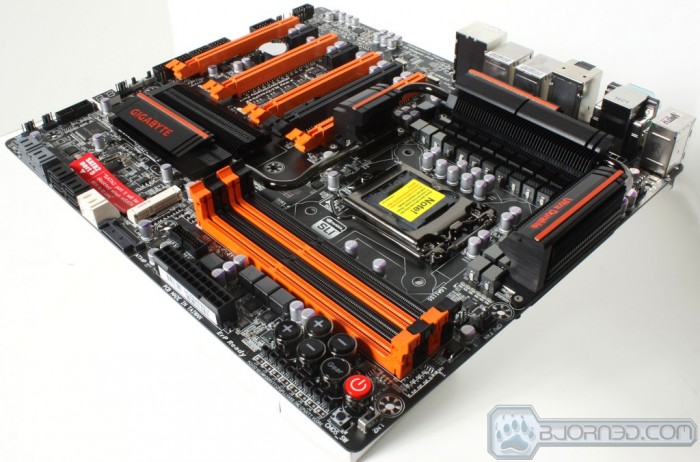





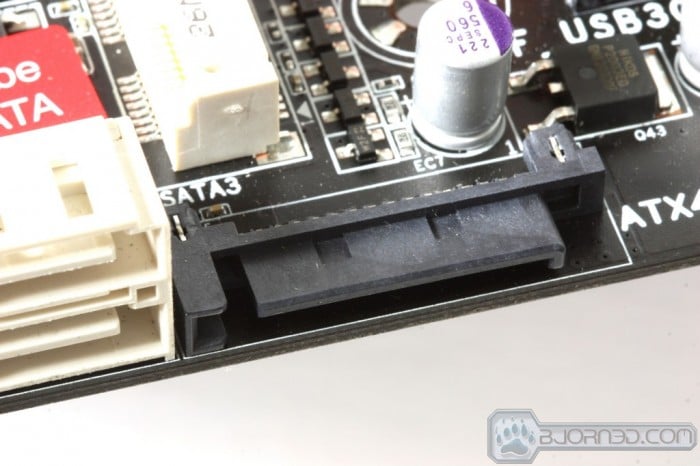


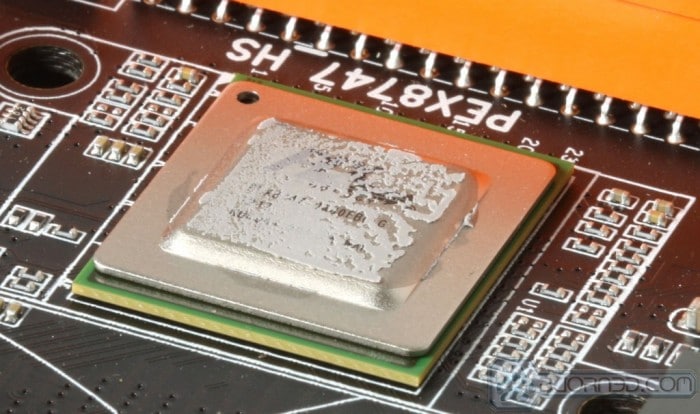






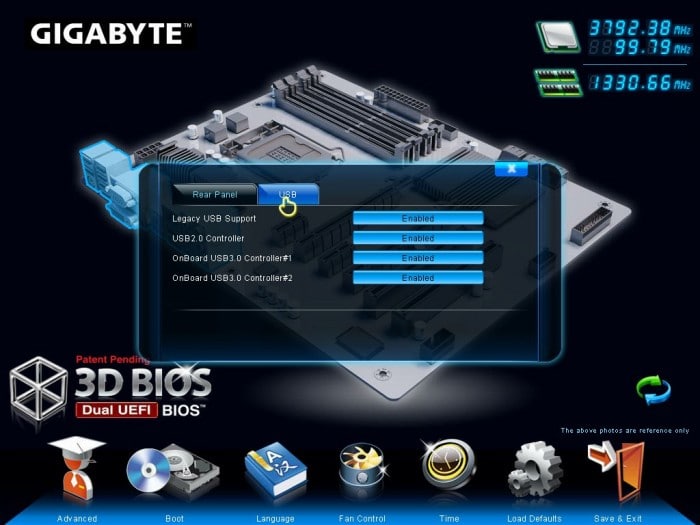
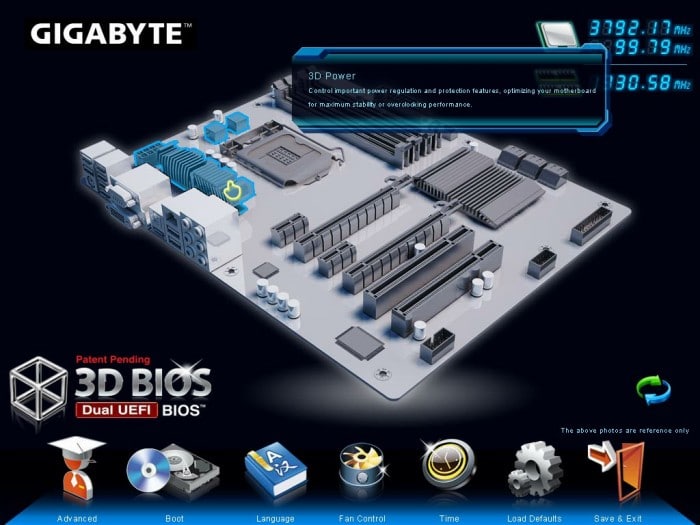











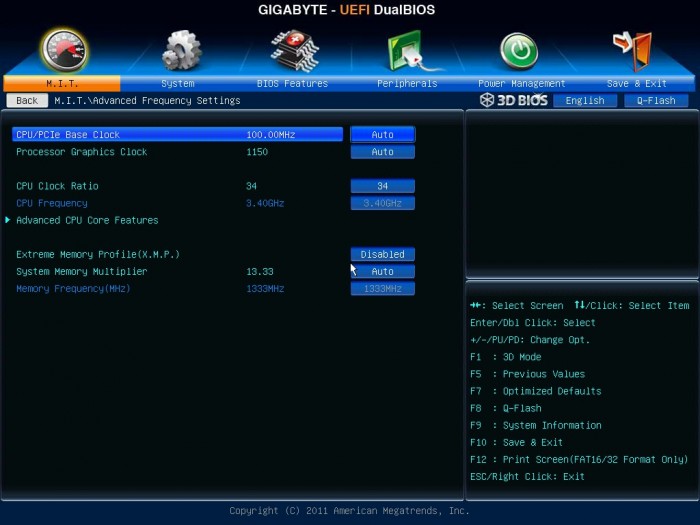







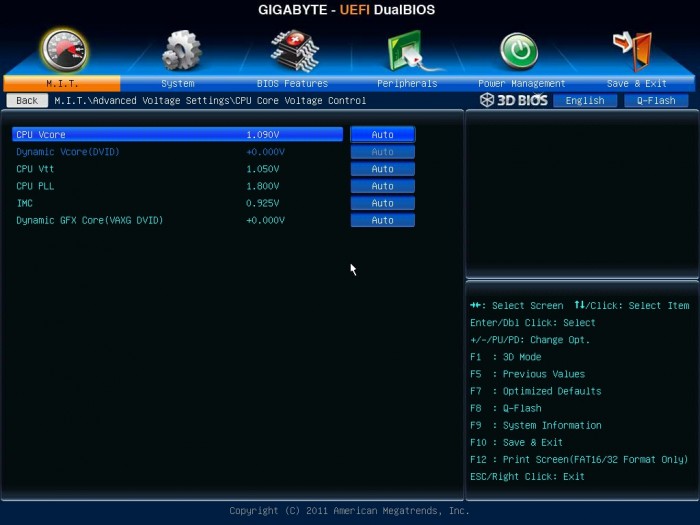






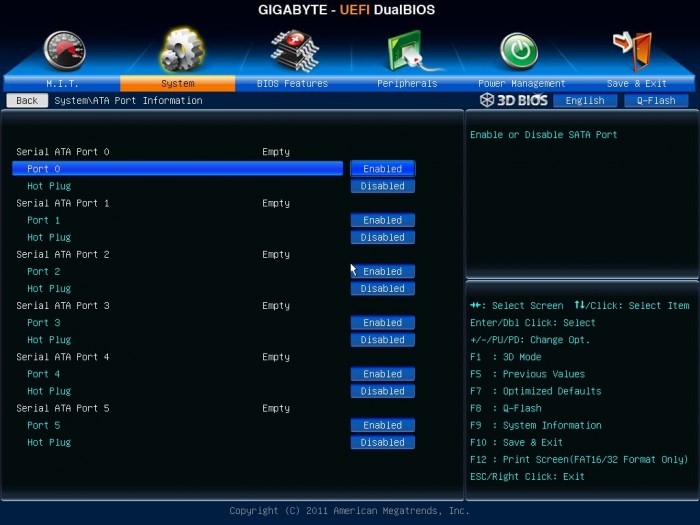


























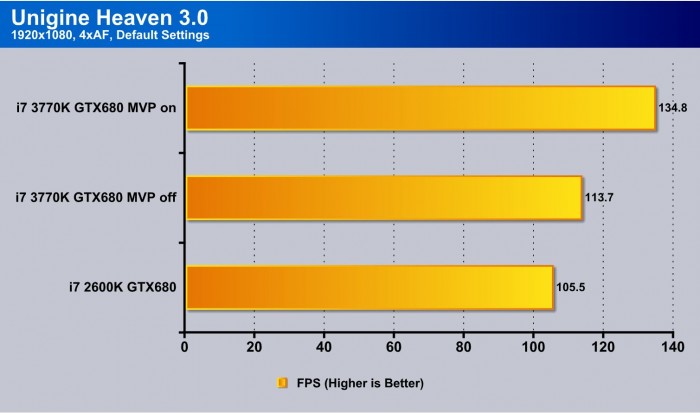





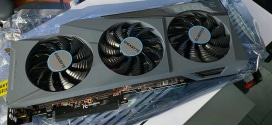






wow i just check the price and it is clearly too much
for the money this board cost i could get Gigabyte GA-Z77X-UD5H-WB WIFI and an Intel i5
Don’t whine about the price,this mobo is design for enthusiast who have money to spare and ask for best performance,You won’t notice the different under air cooling,z77 ud5 is enough to take you to 5ghz.Ud5 won’t be suffice if you ask for 4 way sli and ln2 oc.
Dumb question but 1333MHZ ram won’t work with this…right?
1333MHz RAM will work on this board without any issue.